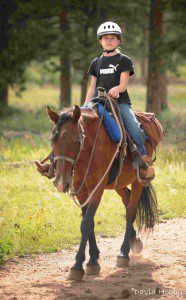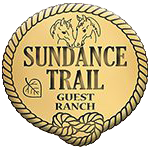
A Dude Ranch Beginner Rider’s Introduction to Horse Communication; Speaking to Your Dude Horse (Part 2)
Horseback riding is a very big part of our lives here at Sundance Trail. We hope you find this little article useful!
Please read part 1 of this series. Different disciplines use different cues to communicate to their horses. Also, geography plays a part, with regional differences sometimes within the same neighborhood!
Folks who have been taught English cues sometimes have problems communicating with our dude ranch horses (especially when they “maintain contact” with the horse’s mouth – which western horses do NOT like!). It is not a question of what is “right or wrong,” it is a question of becoming bi-lingual.
The moral of the story is: “When you go to a new place, learn the local language.”
Sooo………. To ask your dude ranch horse to:
Stand Still –
To stand still, we say “Stand” and may put just a bit of tension on the reins, pulling towards our belly buttons. We are very careful to not kick the horse in any way. If the horse is standing quietly, we can take the small amount of pressure off the reins.
Walk –
To walk, we say “Walk” or we click with our tongues. We are careful to have no tension on the reins, so the horse can move his head forward. We squeeze with our ankles and sit tall in the saddle.
Note: if this is your first time on this dude ranch horse, he/she may choose to start the relationship by being deaf to your cues. It is less work to ignore us and to stand still than it is to actually walk. (This is somewhat akin to asking a 12 year old to clean his/her bedroom.)
This behavior has to do with the horse testing where you and he/she are in the pecking order – we will talk about this in another article. In this case, if the squeeze doesn’t work, one can then repeat the verbal cue and tap-tap-tap, slowly increasing the strength of the tapping until you are actually kicking the animal.
If you are not wearing spurs, and beginners should NOT be wearing spurs, you cannot hurt the animal by kicking him/her with your heels.
At the same time, don’t start by kicking your horse! My horse has very sensitive sides. I never have to kick him. If I did, he probably would take me right over the corral fence and to the next county. “Lazy Leo” on the other hand doesn’t even wake up until you’ve given him a good thump.
Until you know your horse, start gently!
Jog or Trot
To jog or trot, we say “Trot” or we make series of short kissing sounds. With the reins loose so the horse can stretch his head forward, we lean forward just a bit, so we don’t loose balance when the horse actually starts jogging – but we stay in a good tall posture. We then squeeze or tap the horse’s sides with our ankles.
You may ask: Why do we western-to-the-core cowboys and cowgirls use the English term and not the Western? I have no idea! That is what I was taught when I learned our dialect of Horse.
Sitting the trot, standing the trot, and posting the trot are matters for another dude riding article.
Lope or Canter
To lope, we make a long kissing sound, with the reins loose, so the horse can stretch his/her head out just a bit. We also lean just a bit forward and squeeze. This is just like how we moved into the jog.
Once the horse is in the lope, the horse may want to stretch his head out into a full gallop. This may not be a good idea if you are not ready. To control the lope, we take the slack out of the reins (bringing the reins in towards our belly button) to bring the horse’s nose in, and we use the word “Collect.” This has a breaking effect, controlling the horse’s speed.
If you are a beginning or “advanced beginner” rider, and especially if you are not within the confines of an arena, you should do this only under the coaching of your instructor! Horses love to run! If you lope your horse, he may want to go faster than you are comfortable. When he is going faster, he may not want to obey your requests to slow down.
A word to the wise: It is generally understood that a horse’s IQ is inversely related to his or her speed. Now horses are not mental giants to begin with, so be careful to keep his/her attention and maintain control as you go even a bit faster.
Galloping
Is not within the scope of this article! Moving from 10-17 mph to 30-35 mph is a very big step that requires a least a few hours in the saddle, a foundation of sound teaching, and close supervision.
Bumping Your Horse Down (“Down-shifting” your horse)
If you drive a car or truck with a standard transmission, you know that you can use the gears to slow down, from fourth to third to second to first to stopping.
If you are riding a horse who is going faster than you want, you have a choice: you can either yell: “Whoa!” or you can take him or her “down through the gears.”
If you yell “Whoa” to my horse, he will stop. He can go from 35 mph to a dead stop in a matter of a few feet. Riders do not stop so quickly. They tend to fly through the air over the horse’s head into the bushes. The horses find this very entertaining to watch. Humans generally do not.
To slow your horse down, it might be wiser to push your feet out in front of you, lean back a bit, and pull the reins back towards your belly button for a count of three. Then release the pressure a bit for a count of three, then pull back again for a count of three. Continue this cycle until you have slowed to the speed that you want.
Wow! This all sounds so complicated! It’s not really. It just takes a bit of practice and a bit of coaching.
Here at the Sundance Trail, you will find that the wranglers follow set of “learning steps” in their care and feeding of their dude riders. (You educators call this a curriculum – but we don’t want to use words like “curriculum” when we’re being cowboys!) Your wrangler will start you with a “class” on ground manners, then communication, then practice in the arena, and so on. As you feel comfortable, and demonstrate skill in an arena and the trails, your wrangler will add new skills to learn. You will never be bored, and you will never be overwhelmed.
